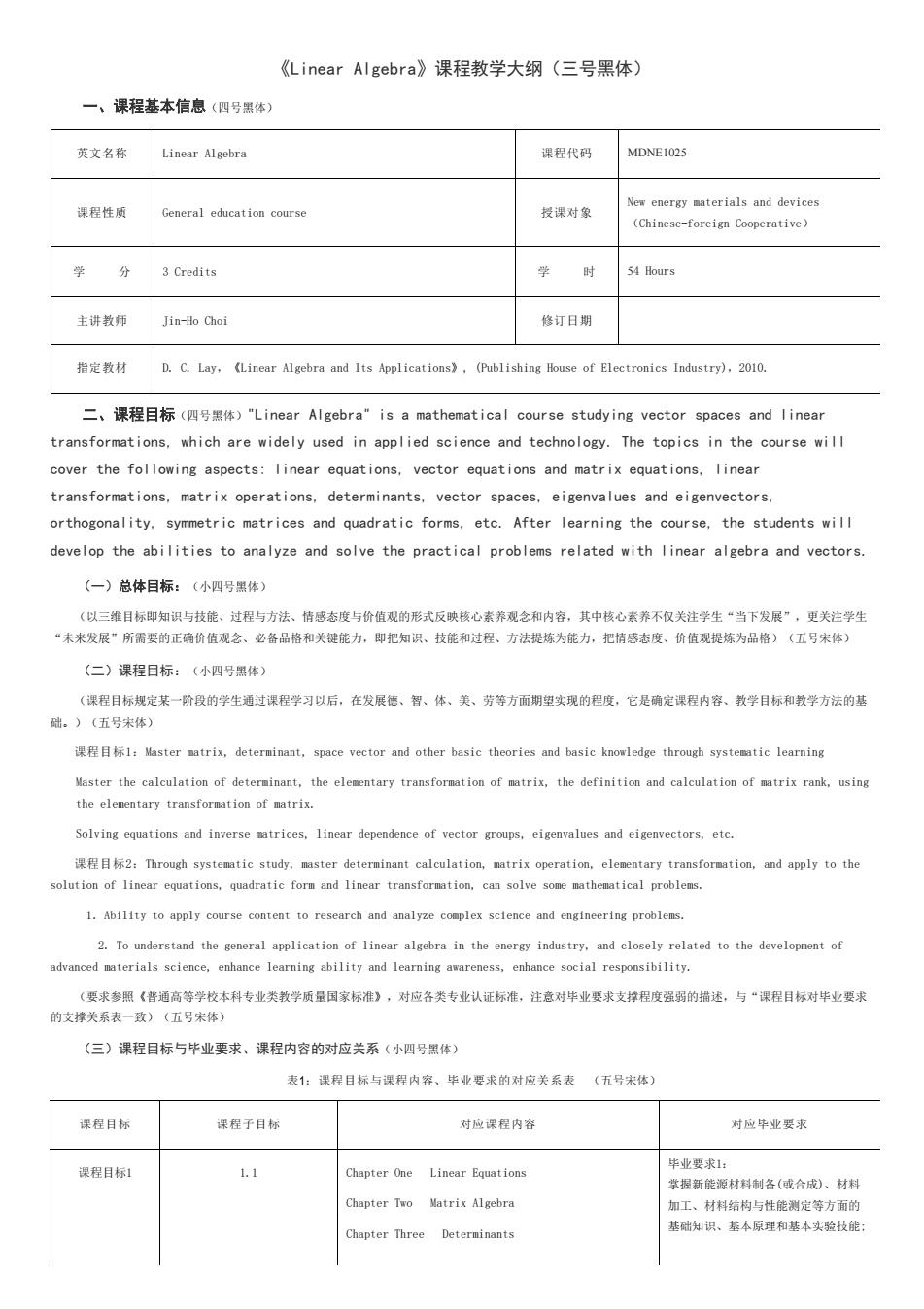
《Linear Algebra》课程教学大纲(三号黑体) 一、课程基本信息〈四号黑体) 英文名称 Linear Algebra 课程代码 课程性质 授课对象 New energy materials and devices (Chinese-foreign Cooperative) 学分 3 Credits 学 54 Hours 主讲教师 Jin-o Choi 修订日期 指定教材 D.C.Lay,(Linear Algebra and Its Applications)(Publishing House of Electronics Industry),2010. 二、课程目标(四号里体)"Linear Algebra"is a mathematica|course studving vector spaces and linear transformations.which are widely used in applied science and technology.The topics in the course will cover the fol lowing aspects:linear equations,vector equations and matrix equations,Iinear transformations.matrix operations,determinants.vector spaces.eigenvalues and eigenvectors. orthogonality.symmetric matrices and quadratic forms.etc.After learning the course.the students will develop the abilities to analyze and solve the practical problems related with linear algebra and vectors (一)总体目标:(小四号黑体 《以三目标知与技能、过程与方法。本与值的形式反隐接心养利内,其中核心素装不仅美注学生“当下罗”,美注学生 “未来发展”所需要的正确价值观名、必备品格和关健能力,即把知识、技能和过、方法提炼为能力,把情感态度、价值观提炼为品格)(五号米体) (二)课程目标:(小四号黑体) (课程目标规定某一阶段的学生通过课程学习以后,在发展德、智、体、美、芳等方面期银实现的程度。它是确定课程内容、教学目标和教学方法的基 础。)《五号宋体) :Master tris deterinant.space vector and other basic theories and basic knowledge through systematic learming Master the calculation of deterinant,the eleentary transformation of mtrix,the definition and calculation of trix rank,using the elenentary transfornation of matrix. Solving equations and inverse matrices.linear dependence of vector groups.eigenvalues and eigenvectors.ete. ions.quadratic form and linear transformation.can solve sone mathematical probleas 1.Ability to apply course content to research and analyze complex science and engineering probles. 2.To understand the general application of linear algebra in the energy industry.and closely related to the developnent of advanced materials science,enhance learning ability and learning awareness,enhance social responsibility. (三)课程目标与毕业要求、课程内容的对应关系(小四号黑体) 表1:课程目标与课程内容、毕业受求的对应关系表(五号宋体) 课程目标 躁程子目标 对应课程内容 对应毕业要求 课程目标1 Chapter ne Linear Equation 业要求 Chapter Two Matrix Algebra 工、材料 燕础知识、基本原理和基本实技能 Chapter Three Determinants
《Linear Algebra》课程教学大纲(三号黑体) 一、课程基本信息(四号黑体) 英文名称 Linear Algebra 课程代码 MDNE1025 课程性质 General education course 授课对象 New energy materials and devices (Chinese-foreign Cooperative) 学 分 3 Credits 学 时 54 Hours 主讲教师 Jin-Ho Choi 修订日期 指定教材 D. C. Lay,《Linear Algebra and Its Applications》, (Publishing House of Electronics Industry),2010. 二、课程目标(四号黑体)"Linear Algebra" is a mathematical course studying vector spaces and linear transformations, which are widely used in applied science and technology. The topics in the course will cover the following aspects: linear equations, vector equations and matrix equations, linear transformations, matrix operations, determinants, vector spaces, eigenvalues and eigenvectors, orthogonality, symmetric matrices and quadratic forms, etc. After learning the course, the students will develop the abilities to analyze and solve the practical problems related with linear algebra and vectors. (一)总体目标:(小四号黑体) (以三维目标即知识与技能、过程与方法、情感态度与价值观的形式反映核心素养观念和内容,其中核心素养不仅关注学生“当下发展”,更关注学生 “未来发展”所需要的正确价值观念、必备品格和关键能力,即把知识、技能和过程、方法提炼为能力,把情感态度、价值观提炼为品格)(五号宋体) (二)课程目标:(小四号黑体) (课程目标规定某一阶段的学生通过课程学习以后,在发展德、智、体、美、劳等方面期望实现的程度,它是确定课程内容、教学目标和教学方法的基 础。)(五号宋体) 课程目标1:Master matrix, determinant, space vector and other basic theories and basic knowledge through systematic learning Master the calculation of determinant, the elementary transformation of matrix, the definition and calculation of matrix rank, using the elementary transformation of matrix. Solving equations and inverse matrices, linear dependence of vector groups, eigenvalues and eigenvectors, etc. 课程目标2:Through systematic study, master determinant calculation, matrix operation, elementary transformation, and apply to the solution of linear equations, quadratic form and linear transformation, can solve some mathematical problems. 1.Ability to apply course content to research and analyze complex science and engineering problems. 2. To understand the general application of linear algebra in the energy industry, and closely related to the development of advanced materials science, enhance learning ability and learning awareness, enhance social responsibility. (要求参照《普通高等学校本科专业类教学质量国家标准》,对应各类专业认证标准,注意对毕业要求支撑程度强弱的描述,与“课程目标对毕业要求 的支撑关系表一致)(五号宋体) (三)课程目标与毕业要求、课程内容的对应关系(小四号黑体) 表1:课程目标与课程内容、毕业要求的对应关系表 (五号宋体) 课程目标 课程子目标 对应课程内容 对应毕业要求 课程目标1 1.1 Chapter One Linear Equations Chapter Two Matrix Algebra Chapter Three Determinants 毕业要求1: 掌握新能源材料制备(或合成)、材料 加工、材料结构与性能测定等方面的 基础知识、基本原理和基本实验技能;
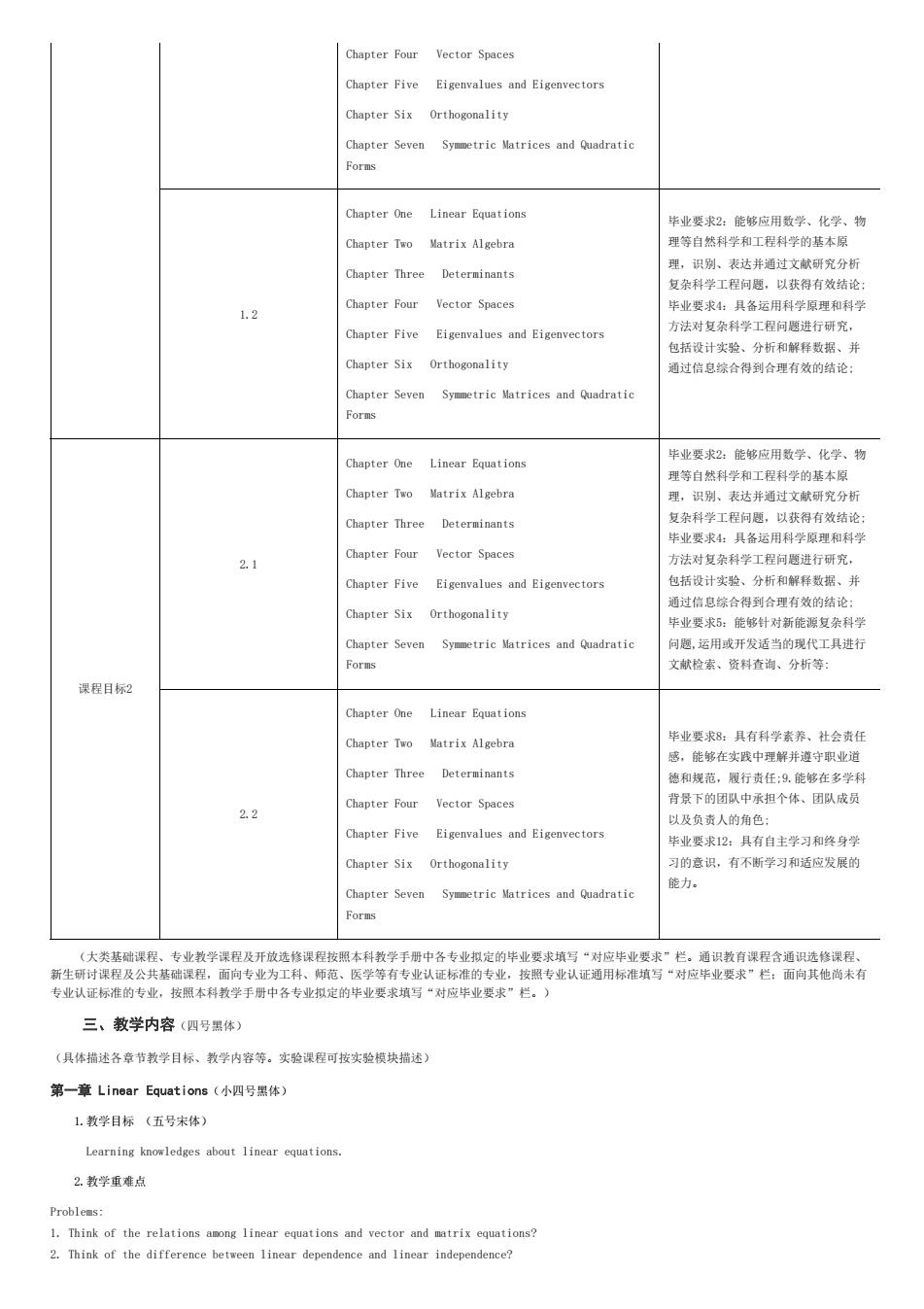
Chapter Four Vector Spaces Chapter Six Orthogonality Chapter Seven Symetric Vatrices and Quadratic Foras Chapter One Linear Equation 毕业要求2:能够应用数学、化学,物 Chapter Two Matrix Algebra 理等白然科学和工程科学的基本 Chapter Three Deterainants 理,识、表达并过文原究分日 1.2 Chapter Four Vector Spaces Chapter Five Elgenvalues and Eigenvectors 方法对复杂科 Chapter Six Orthogonality 通过信息综合符到合理有效的结论: atrices and Qdratic Chapter One Linear Equation 毕业要求:能够应用数学、化学、物 理等料学和工程料学的基本 Chapter Two Matrix Algebra 现,识别、表达并通过 做酹究分 Chapter Three Determinants 2.1 Chapter Four Yector Spaces hapter Five Eigenvaluesand Eigenvectors 通过信自修合料到合理有领的结论 Chapter Six Ortbogonality 账要求5:能够针对新作源复杂科 Chapter Seven Symetric Vatrices and Quadratic 问题,运用或开发适当的现代工具进行 文就检索、资料查询、分析等 误程目标阅 Chapter One Linear Equations Chapter Two Matrix Algebra 毕业婴求8:具有科学素养、社会责任 成,能够在士资中理解并道守职业过 德和规范,履行责任:9.能够在多学利 22 Chapter Four Vector Spaces 背景下的图队中承担个体、团队成员 Chapter Five Eigenvalues and Eigenvectors 以及负黄人的角色 Chapter Six Orthogonality ter Seven and Qudratic (大类基础课、专业教学课程及开放选修课程技照本科教学手册中各专业定的毕业要求填写“对应毕业要求“栏。通识教育课程含通识选修误程 三、教学内容(四号里体) (具体描送各章节教学目标、教学内容等。实验课程可按实验模块描透 第一章Linear Equations(小四号黑体) 1.教学目标(五号宋体) 2学重难点 Probleans: 1.Think of the relations aong linear equations and vector and matrix equations? 2.Think of the difference between linear dependence and linear independence?
Chapter Four Vector Spaces Chapter Five Eigenvalues and Eigenvectors Chapter Six Orthogonality Chapter Seven Symmetric Matrices and Quadratic Forms 1.2 Chapter One Linear Equations Chapter Two Matrix Algebra Chapter Three Determinants Chapter Four Vector Spaces Chapter Five Eigenvalues and Eigenvectors Chapter Six Orthogonality Chapter Seven Symmetric Matrices and Quadratic Forms 毕业要求2:能够应用数学、化学、物 理等自然科学和工程科学的基本原 理,识别、表达并通过文献研究分析 复杂科学工程问题,以获得有效结论; 毕业要求4:具备运用科学原理和科学 方法对复杂科学工程问题进行研究, 包括设计实验、分析和解释数据、并 通过信息综合得到合理有效的结论; 课程目标2 2.1 Chapter One Linear Equations Chapter Two Matrix Algebra Chapter Three Determinants Chapter Four Vector Spaces Chapter Five Eigenvalues and Eigenvectors Chapter Six Orthogonality Chapter Seven Symmetric Matrices and Quadratic Forms 毕业要求2:能够应用数学、化学、物 理等自然科学和工程科学的基本原 理,识别、表达并通过文献研究分析 复杂科学工程问题,以获得有效结论; 毕业要求4:具备运用科学原理和科学 方法对复杂科学工程问题进行研究, 包括设计实验、分析和解释数据、并 通过信息综合得到合理有效的结论; 毕业要求5:能够针对新能源复杂科学 问题,运用或开发适当的现代工具进行 文献检索、资料查询、分析等: 2.2 Chapter One Linear Equations Chapter Two Matrix Algebra Chapter Three Determinants Chapter Four Vector Spaces Chapter Five Eigenvalues and Eigenvectors Chapter Six Orthogonality Chapter Seven Symmetric Matrices and Quadratic Forms 毕业要求8:具有科学素养、社会责任 感,能够在实践中理解并遵守职业道 德和规范,履行责任;9.能够在多学科 背景下的团队中承担个体、团队成员 以及负责人的角色; 毕业要求12:具有自主学习和终身学 习的意识,有不断学习和适应发展的 能力。 (大类基础课程、专业教学课程及开放选修课程按照本科教学手册中各专业拟定的毕业要求填写“对应毕业要求”栏。通识教育课程含通识选修课程、 新生研讨课程及公共基础课程,面向专业为工科、师范、医学等有专业认证标准的专业,按照专业认证通用标准填写“对应毕业要求”栏;面向其他尚未有 专业认证标准的专业,按照本科教学手册中各专业拟定的毕业要求填写“对应毕业要求”栏。) 三、教学内容(四号黑体) (具体描述各章节教学目标、教学内容等。实验课程可按实验模块描述) 第一章 Linear Equations(小四号黑体) 1.教学目标 (五号宋体) Learning knowledges about linear equations. 2.教学重难点 Problems: 1. Think of the relations among linear equations and vector and matrix equations? 2. Think of the difference between linear dependence and linear independence?
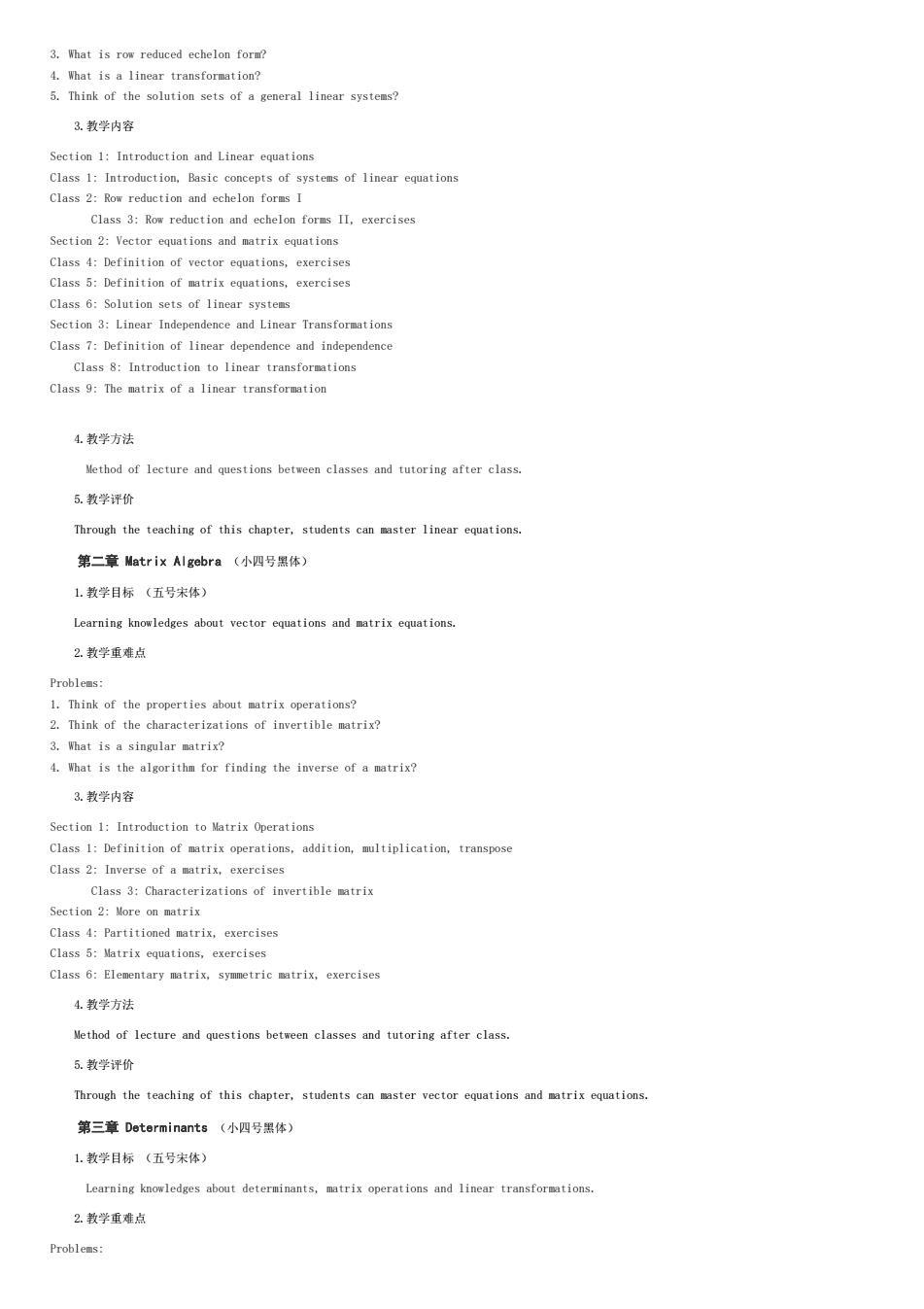
sets of a general linear systeas? 3.教学内容 Section1:Introduction and Linear equations Class1:Introduction.Basic concepts of systes of linear eations Class 2:Row reduction and echelon fors Class3:Row reduction and echelon forms II.exercises Ca5iefintiootaTiCatioms,ercie Class 8:Solution sots of linear sxstems Section 3:Linear Independence and Linear Transformations Class 7:Definition of linear dependence and independenc Class 8:Introduction to linear transformations Class 9:The natrix of a linear transformation 4.教学方法 Nethod of lecture and questions between classes and tutoring after class 5.教学评价 Through the teaching of this chapter,students can aster linear eqations 第二章Matrix Algobra(小四号黑体) 1.教学日标(五号宋体) Learning knowledges about vector equations and matrix equations. 2教学重难 1.Think of the properties about matrix operations? 2.Think of the characterizations of invertible atrix? 3.What is a singular matrix? 4.What is the algoritha for finding the inverse of a matrix? 3.教学内容 Section I:Introduction to Natrix Operation Class 1:Definition of tri operations,addition,mltiplication,transpose Class 2:Inverse of a mtrix.erercises Class 3:Characterizations of invertibleatrix Section 2:More on natrix Class 4:Partitioned natris,exercises Class 5:Matrix equations,exercises 4.教学方法 Method of lecture and questions between classes and tutoring after class. 教学评价 Through the teaching of this chapter,students can aster vector equations eqution 第三章Determinants(小号黑体) 1.教学目标(五号宋体) Learning knowledges ahout deterninants.matrix operations and linear transformations 2教学重难点
3. What is row reduced echelon form? 4. What is a linear transformation? 5. Think of the solution sets of a general linear systems? 3.教学内容 Section 1: Introduction and Linear equations Class 1: Introduction, Basic concepts of systems of linear equations Class 2: Row reduction and echelon forms I Class 3: Row reduction and echelon forms II, exercises Section 2: Vector equations and matrix equations Class 4: Definition of vector equations, exercises Class 5: Definition of matrix equations, exercises Class 6: Solution sets of linear systems Section 3: Linear Independence and Linear Transformations Class 7: Definition of linear dependence and independence Class 8: Introduction to linear transformations Class 9: The matrix of a linear transformation 4.教学方法 Method of lecture and questions between classes and tutoring after class. 5.教学评价 Through the teaching of this chapter, students can master linear equations. 第二章 Matrix Algebra (小四号黑体) 1.教学目标 (五号宋体) Learning knowledges about vector equations and matrix equations. 2.教学重难点 Problems: 1. Think of the properties about matrix operations? 2. Think of the characterizations of invertible matrix? 3. What is a singular matrix? 4. What is the algorithm for finding the inverse of a matrix? 3.教学内容 Section 1: Introduction to Matrix Operations Class 1: Definition of matrix operations, addition, multiplication, transpose Class 2: Inverse of a matrix, exercises Class 3: Characterizations of invertible matrix Section 2: More on matrix Class 4: Partitioned matrix, exercises Class 5: Matrix equations, exercises Class 6: Elementary matrix, symmetric matrix, exercises 4.教学方法 Method of lecture and questions between classes and tutoring after class. 5.教学评价 Through the teaching of this chapter, students can master vector equations and matrix equations. 第三章 Determinants (小四号黑体) 1.教学目标 (五号宋体) Learning knowledges about determinants, matrix operations and linear transformations. 2.教学重难点 Problems:
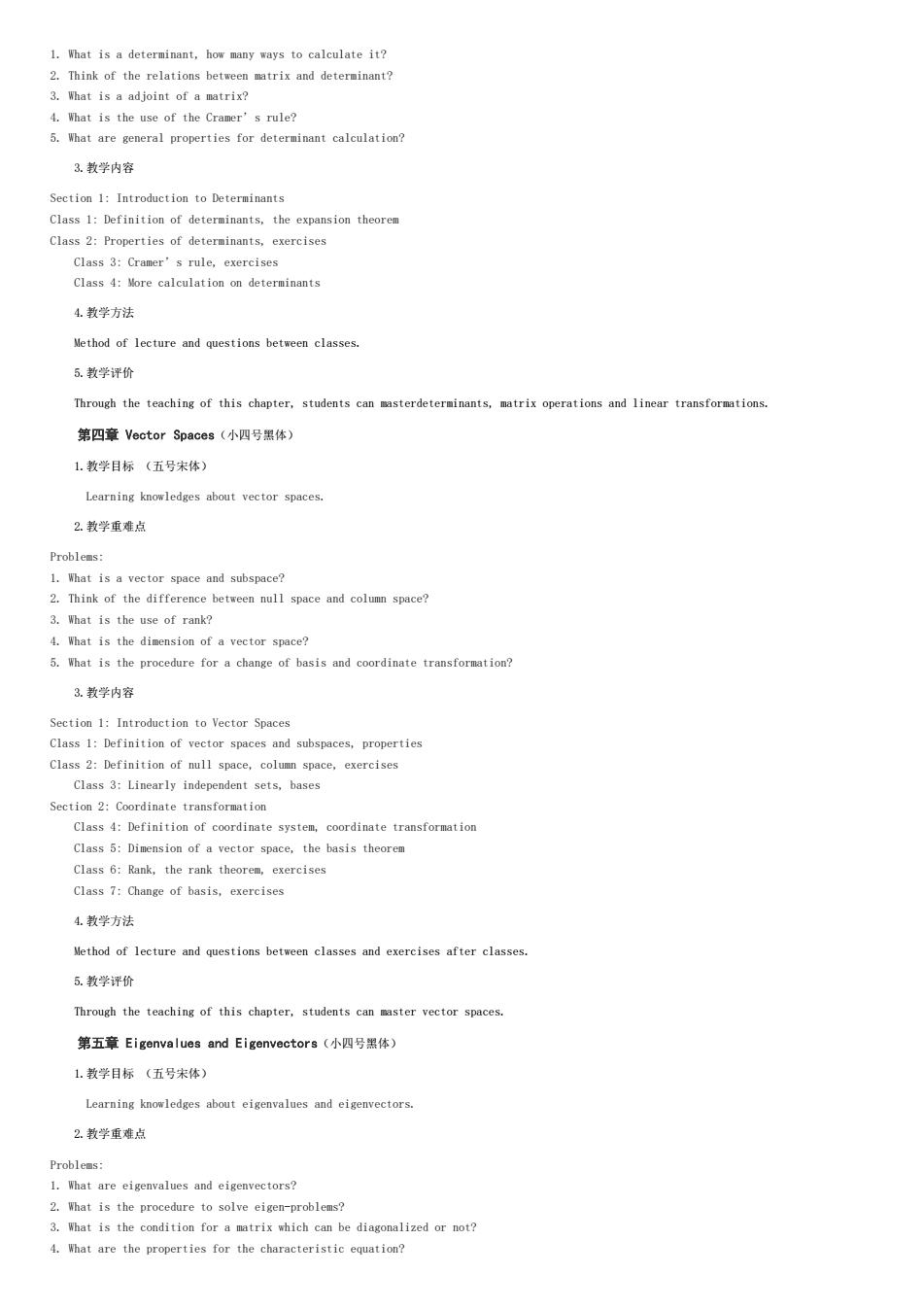
1.hat is a determinant,how many ways to calculate it? What is a adjoint of a matrix? 3.教学内容 Section:Introdction to Deterins Class Class Froperties of determinants,exercises 4.教学方法 Nethod of lecture and questions between classes 5教学评价 Through the teaching of this chapter.students can sasterdeterminants.matrix operations and lipear transfornations 第四章V6 ctor Spa088(小四号黑体) 1.教学目标(五号宋体) 2教学重难点 Probleas: 1.What is a vector space and subspace? 2.Think of the difference between null space and column space? 3.What is the use of rank? 4.hat is the dimension of a vector space? 5.hat is the procedure fora change of basis and coordinate 3.教学内容 Section 1:Introduction to Vector Spaces Class 1:Definition of vector spaces and subspaces,properties Class 2:Definition of mll space,column space,exercises Class 3:Linearly independent sets.bases Class 7:Change of basis,exercises 4教学方法 Nethod of lecture and estios betseen classes and exercises after classes 5.教学评价 Through the teaching of this chapter,students can master vector spaces. 第五章Eigenvalues and Eigenvectors(小四号黑体) 1.教学目标(五号宋体 2.教学重难点 1.What are eigenvalues and eigenvectors? rop equ
1. What is a determinant, how many ways to calculate it? 2. Think of the relations between matrix and determinant? 3. What is a adjoint of a matrix? 4. What is the use of the Cramer’s rule? 5. What are general properties for determinant calculation? 3.教学内容 Section 1: Introduction to Determinants Class 1: Definition of determinants, the expansion theorem Class 2: Properties of determinants, exercises Class 3: Cramer’s rule, exercises Class 4: More calculation on determinants 4.教学方法 Method of lecture and questions between classes. 5.教学评价 Through the teaching of this chapter, students can masterdeterminants, matrix operations and linear transformations. 第四章 Vector Spaces(小四号黑体) 1.教学目标 (五号宋体) Learning knowledges about vector spaces. 2.教学重难点 Problems: 1. What is a vector space and subspace? 2. Think of the difference between null space and column space? 3. What is the use of rank? 4. What is the dimension of a vector space? 5. What is the procedure for a change of basis and coordinate transformation? 3.教学内容 Section 1: Introduction to Vector Spaces Class 1: Definition of vector spaces and subspaces, properties Class 2: Definition of null space, column space, exercises Class 3: Linearly independent sets, bases Section 2: Coordinate transformation Class 4: Definition of coordinate system, coordinate transformation Class 5: Dimension of a vector space, the basis theorem Class 6: Rank, the rank theorem, exercises Class 7: Change of basis, exercises 4.教学方法 Method of lecture and questions between classes and exercises after classes. 5.教学评价 Through the teaching of this chapter, students can master vector spaces. 第五章 Eigenvalues and Eigenvectors(小四号黑体) 1.教学目标 (五号宋体) Learning knowledges about eigenvalues and eigenvectors. 2.教学重难点 Problems: 1. What are eigenvalues and eigenvectors? 2. What is the procedure to solve eigen-problems? 3. What is the condition for a matrix which can be diagonalized or not? 4. What are the properties for the characteristic equation?
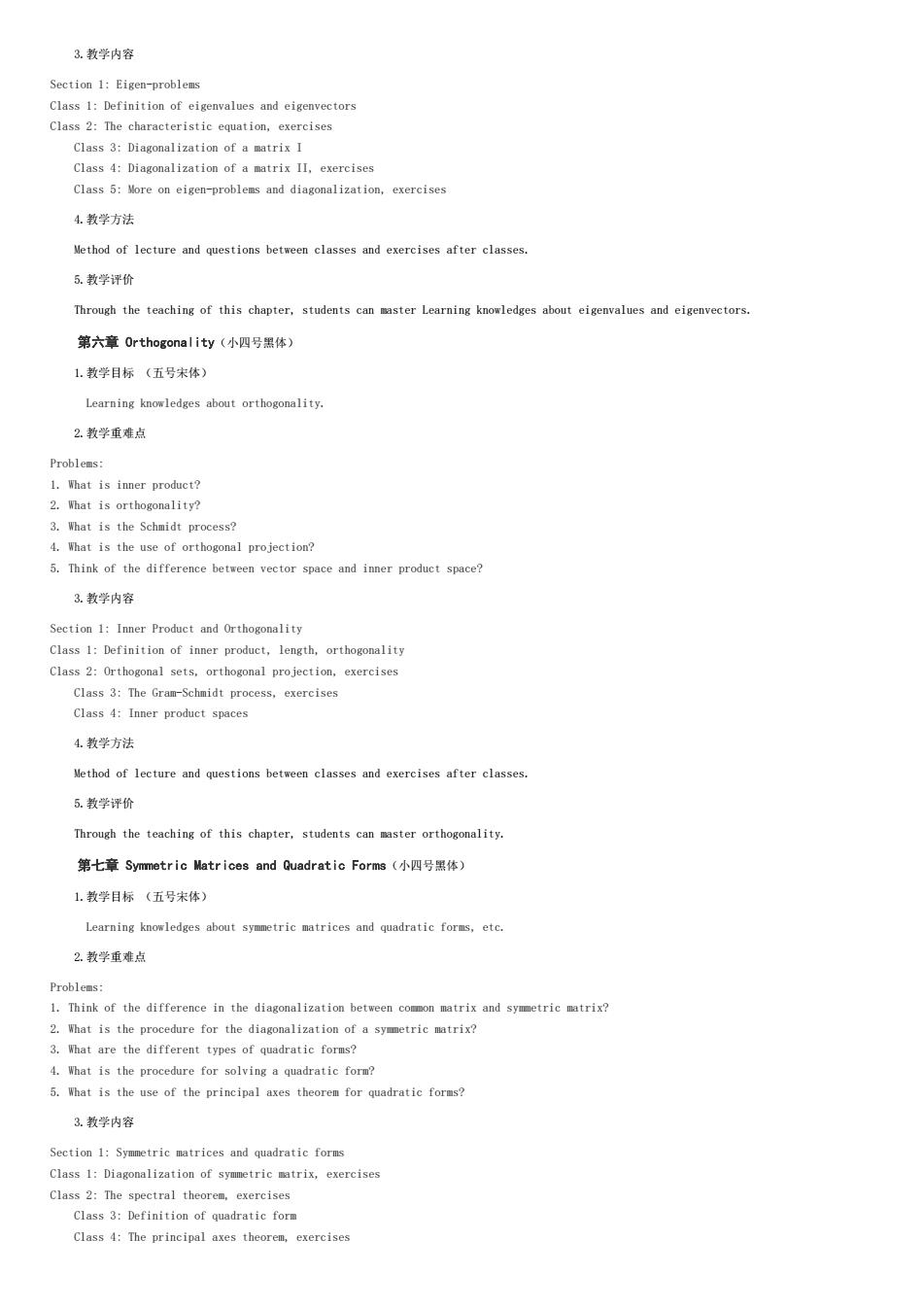
3教学内容 Section 1:Eigen-nrobleas Class 2:The characteristic eio exercises Class 3:Diagonalization of a matrix I Class 4:Diagonalization of a matrix II,exercises Class:Wore on eigeroe and diagonalization,exercises 4教学方法 Nethod of lecture and questloas between classes and exereises after classes 5.教学评价 Through the teaching of this chapter,students can ter earing koledges about eigenalues and eigevectors. 第六章0 rthogonality(小四号黑体) 1.教学目标(五号体) Learning knowledges about orthogoality. 2.教学重难点 3 What is the schuldt nrocess? 4.What is the use of orthogonal projcction? 5.Think of the difference between vector space and inmer product space? 3教学内容 Class:The Gran-Schaidt process,exercises Class 4:Inmer product spaces 4.教学方法 5教学评价 Through the teaching of this chapter,students can master orthogonality. 第七章Symetric Matrices and Quadratio Forms(小四号黑体) 1.教学目标(五号宋体) 2.教学重难点 at are the different tyes of auratie for 5.hat is the use of the principal axes theoren for quadratic forms? 3.教学内容 Class m Class3:Definition of guadratie for Class 4:The principal axes theoren,exercises
3.教学内容 Section 1: Eigen-problems Class 1: Definition of eigenvalues and eigenvectors Class 2: The characteristic equation, exercises Class 3: Diagonalization of a matrix I Class 4: Diagonalization of a matrix II, exercises Class 5: More on eigen-problems and diagonalization, exercises 4.教学方法 Method of lecture and questions between classes and exercises after classes. 5.教学评价 Through the teaching of this chapter, students can master Learning knowledges about eigenvalues and eigenvectors. 第六章 Orthogonality(小四号黑体) 1.教学目标 (五号宋体) Learning knowledges about orthogonality. 2.教学重难点 Problems: 1. What is inner product? 2. What is orthogonality? 3. What is the Schmidt process? 4. What is the use of orthogonal projection? 5. Think of the difference between vector space and inner product space? 3.教学内容 Section 1: Inner Product and Orthogonality Class 1: Definition of inner product, length, orthogonality Class 2: Orthogonal sets, orthogonal projection, exercises Class 3: The Gram-Schmidt process, exercises Class 4: Inner product spaces 4.教学方法 Method of lecture and questions between classes and exercises after classes. 5.教学评价 Through the teaching of this chapter, students can master orthogonality. 第七章 Symmetric Matrices and Quadratic Forms(小四号黑体) 1.教学目标 (五号宋体) Learning knowledges about symmetric matrices and quadratic forms, etc. 2.教学重难点 Problems: 1. Think of the difference in the diagonalization between common matrix and symmetric matrix? 2. What is the procedure for the diagonalization of a symmetric matrix? 3. What are the different types of quadratic forms? 4. What is the procedure for solving a quadratic form? 5. What is the use of the principal axes theorem for quadratic forms? 3.教学内容 Section 1: Symmetric matrices and quadratic forms Class 1: Diagonalization of symmetric matrix, exercises Class 2: The spectral theorem, exercises Class 3: Definition of quadratic form Class 4: The principal axes theorem, exercises